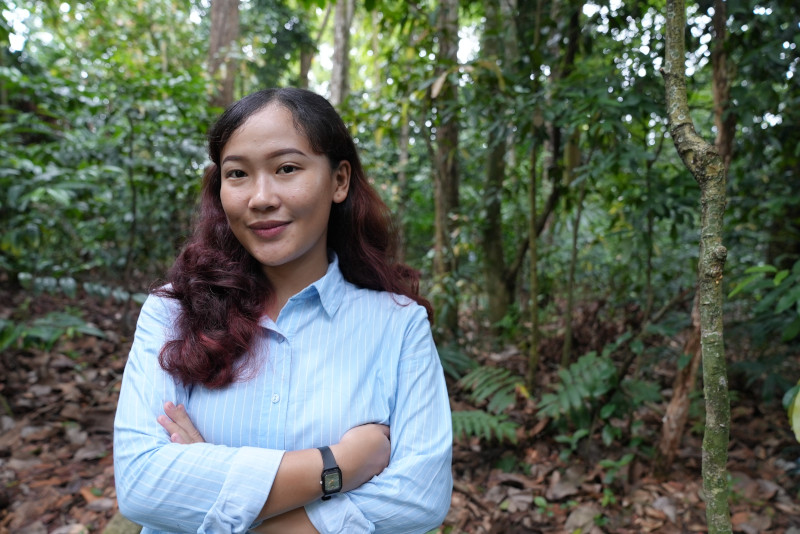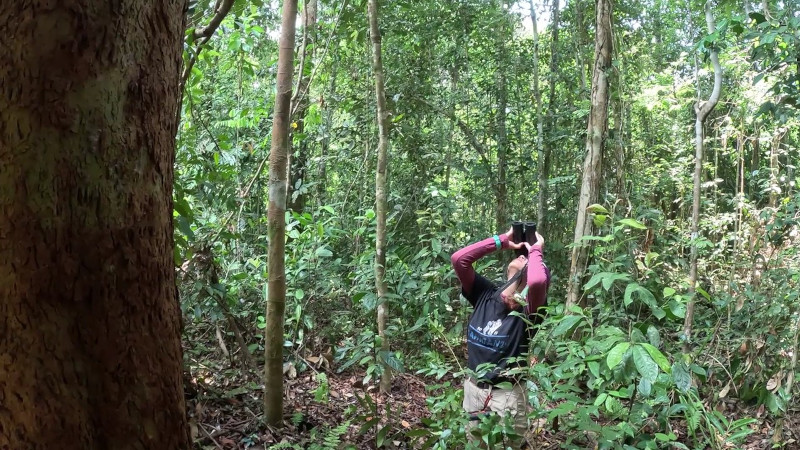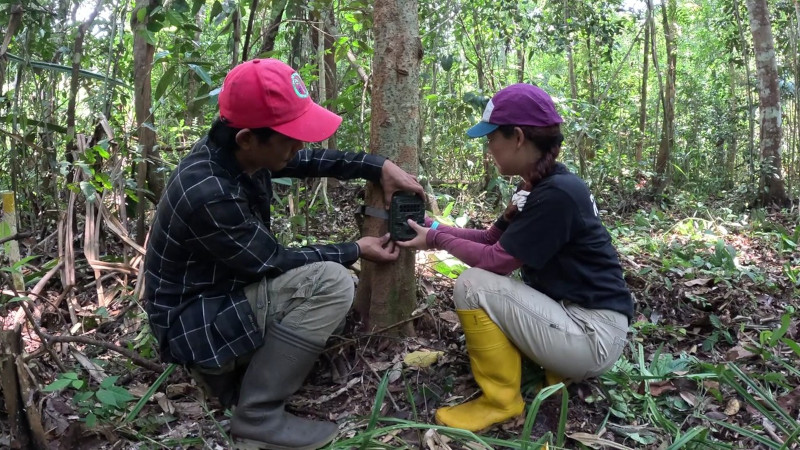January 15, 2025
Located on the Kampar Peninsula in Sumatra, Restorasi Ekosistem Riau (RER) is a pioneering initiative, devoted to restoring and protecting peatland ecosystems in Indonesia and conserving the biodiversity they support.
Aligned with this commitment, the program is continually working to further scientific exploration, by welcoming expert researchers in various fields from locations around the world. From August–November 2024, RER hosted a pair of wildlife conservationists, from the UK and Indonesia, to aid in the study and preservation of the Malayan sun bear (Helarctos malayanus).
Dr David Lee, from the University of South Wales in the UK, and Meisye Wulandari, a Master’s student at IPB University in Bogor, Indonesia, spent three months working at RER on the Kampar Peninsula, where they monitored evidence of sun bears in the wild. Their combined research contributions are helping to further biodiversity science and support the success of ongoing wildlife conservation efforts for sun bears in RER.

From Mapping to Management: Research Objectives
For Lee and Wulandari, the most recent research was an opportunity to generate important ecological information from an under-studied region in the sun bears’ range. Their combined work contributed to the IUCN Species Survival Commission (BSG) and its ongoing revision of sun bear conservation assessments, which includes range-based evidence to support a process of Asian bear species distribution mapping that began in 2023.
Previous research has shown that sun bears are more likely to use undisturbed lowland forests, as these areas can provide more fruit than forests at a higher elevation. When large, fruiting trees and other food sources disappear from a landscape, so too do the sun bears that feed on them. Therefore, the presence of these animals can also be considered a positive indicator of successful peatland restoration; vital information for the RER program.
This project also contributed to RER’s long-term management strategy for the Kampar Peninsula by building up a detailed picture of habitat utilization and occupancy-based population changes in the region by a highly threatened species. By generating more detailed insights into sun bear distribution and land use, RER aims to improve the efficacy of ongoing landscape conservation management for the region.

Distribution and Habitat Use: Research Findings
Based on an extensive camera trap survey conducted by the two researchers, it was discovered that Malayan sun bears are both abundant and widely distributed on the Kampar Peninsula; in fact, this large mammal species was the second most frequently observed species in the area, after the pig-tailed macaque. Sun bears were observed across all four classes of forest condition identified in the study, including the boundaries of fiber plantations.
These results suggest potential for the site to provide a stronghold for the species. The researchers noticed that Malayan sun bears select their habitat based on food availability and security, favoring interior forest but also foraging in secondary, logged, and regenerating burnt forests. Sun bears were also found feeding in, and traveling through non-natural vegetation, in agricultural areas at the forest periphery.
Upon completion of the project in November, Wulandari stated that “witnessing evidence of these animals’ existence in the wild left me in awe of the forest and its inhabitants,” before adding that support from RER was critical to its success: “the RER team, including field staff, forest rangers, and other personnel, provided invaluable technical assistance and shared essential knowledge about the RER ecosystem,” she said.

A Hub for Knowledge and Discovery: Eco-Research Camp
In 2020, RER developed the Eco-Research Camp to serve as a tropical peatland science hub, with facilities that provide international researchers like Lee and Wulandari with a base camp for their studies. The wider mission is to build collaborative networks with NGOs, research institutions, and universities throughout Indonesia and around the world, in order to advance scientific understanding of tropical peatland ecosystems, foster the development of innovative monitoring techniques, and promote the dissemination of research findings.
“RER provides excellent support for research activities with its eco-research camp,” says Wulandari, who describes the camp as “a well-designed facility that offers comfortable accommodation, electricity, internet access, a laboratory, and spaces for discussion and data analysis—perfectly tailored to support research in remote environments like peat forests.”
New Hope for the Future of Conservation
The research not only gathered valuable information about Malayan sun bears which can inform conservation strategies; it demonstrated the benefits provided by collaboration between academia and the private sector in conserving threatened species. Research methodology developed during this study will subsequently be applied to long-term monitoring of other mammal species, thereby helping to expand RER’s understanding of the landscape and further its research and restoration goals.
Moving forward, research from Lee and Wulandari will provide both a foundation for additional study and the inspiration for conservation commitments. “Unique findings (generated) during the research, and exciting footage from camera traps showing Malayan sun bear activities, are the ultimate reward for all our efforts,” says Wulandari. “These moments fuel my commitment to continue this important work.” By advancing the collective understanding of sun bear distribution and use of habitats, the latest combined RER research bodes well for the future of this threatened species. For Wulandari, it has been an uplifting experience, and one that she will carry into her subsequent work.
“RER has left a profound impression on me,” she says. “Its well-maintained ecosystem demonstrates that commitment to restoration and conservation can create meaningful impacts.” Wulandari also notes that the presence of rare species like the Malayan sun bear in RER provides new hope for the future of conservation. “For me, RER symbolizes successful restoration efforts and serves as an inspiration for similar projects in other areas. Every piece of data we collect is a step toward effective conservation management.”